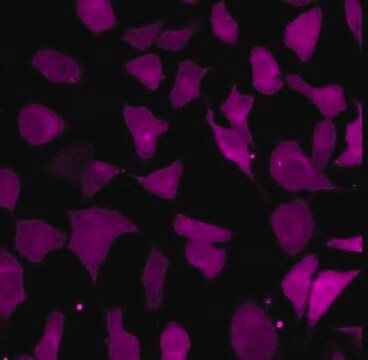ECM910
MDR1 Efflux Assay
The Multidrug Resistance Direct Dye Efflux Assay Kit includes two of the best characterized & most commonly used multidrug resistance ABC transporter substrates, DiOC2(3) & rhodamine 123.
About This Item
Recommended Products
Quality Level
species reactivity (predicted by homology)
mammals
manufacturer/tradename
Chemicon®
technique(s)
cell based assay: suitable
NCBI accession no.
UniProt accession no.
detection method
fluorometric
Application
Cell Structure
Two conveniently formulated solutions of MDR1, MRP1 and BCRP substrate dyes, DiOC2(3) Solution and Rhodamine 123 Solution, are included in the kit to give the investigator flexibility in the substrate specificity of the efflux probe. In addition, a solution of a nonfluorescent substrate of MDR1 and MRP1, Vinblastine Solution, is provided to serve as a competitive inhibitor of dye efflux. DMSO is included as a diluent control for the Vinblastine Solution. Sterile, concentrated RPMI-1640 and BSA are provided as components for buffer for the loading, efflux and washing steps of the procedure. A sterile, concentrated solution of gentamicin, which has been shown to not be a substrate for MDR1 (Mechetner and Roninson, 1992), is supplied as an optional antibiotic for the buffer. Propidium iodide solution is included to identify dead cells and exclude them from the analysis.
The extent of efflux of fluorescent dyes is best analyzed by flow cytometry. The assay can also be incorporated with immunostaining experiments for multicolor analysis of cell surface marker expression and MDR1, MRP1 and BCRP function. Efflux mediated by MDR1, MRP1 and BCRP can also be quantified by analysis under a fluorescence microscope or on a fluorometric plate reader.
The efflux activity of MDR1 and its relatives is highly temperature sensitive. MDR1 functions optimally near 37ºC, but is effectively inactive at 4ºC. MDR1-expressing cells preloaded with MDR1 fluorescent substrates retain the dye and consequently have high fluorescence when incubated at 4ºC (Figure 1, 4ºC, top panels). Conversely, cells incubated at 37ºC more readily efflux the dye and show reduced fluorescence (Figure 1, 37ºC + DMSO, middle panels). The kit also includes a specific inhibitor vinblastine, which is also a substrate for MDR1 and competitively blocks efflux of DiOC2(3) and Rhodamine 123. Inclusion of excess vinblastine in the efflux reaction at 37ºC therefore results in high fluorescence (Figure 1, 37ºC + vinblastine, bottom panels).
For Research Use Only; Not for use in diagnostic or in vivo procedures
Components
Sterile 30% BSA (Part No. 90303) - One bottle containing 35 ml sterile-filtered 30% bovine serum albumin (BSA) in PBS.
Gentamicin Solution, 1000x (Part No. 90353) - One vial containing 1 ml sterile-filtered 50 mg/ml gentamicin.
DiOC2(3) Solution (Part No. 90299) - One vial containing 50 μl of DiOC2(3) (3,3′-diethyloxacarbocyanine iodide) at 1 mg/ml in DMSO.
Rhodamine 123 Solution (Part No. 90300) - One vial containing 0.5 ml of rhodamine 123 at 1 mg/ml in DMSO.
Vinblastine Solution (Part No. 90301) - One vial containing 150 μl of 22 mM vinblastine in DMSO.
DMSO (Part No. 90294) - One vial containing 150 μl DMSO.
Propidium Iodide Stock Solution (Part No. 90296) - One vial containing 1 ml of 50 μg/ml propidium iodide in PBS.
Storage and Stability
Precautions
Propidium Iodide, Gentamicin, Vinblastine, Rhodamine 123 and DiOC2(3) may have toxic effects if handled improperly. DMSO is absorbed through the skin and can facilitate internalization of toxic agents. Use caution when handling each of these components. Standard precautions include wearing gloves and a lab coat.
Legal Information
Disclaimer
Signal Word
Danger
Hazard Statements
Precautionary Statements
Hazard Classifications
Muta. 2 - Resp. Sens. 1 - Skin Sens. 1
Storage Class Code
10 - Combustible liquids
Flash Point(F)
188.6 °F
Flash Point(C)
87 °C
Regulatory Listings
Regulatory Listings are mainly provided for chemical products. Only limited information can be provided here for non-chemical products. No entry means none of the components are listed. It is the user’s obligation to ensure the safe and legal use of the product.
FSL
Group 4: Flammable liquids
Type 3 petroleums
Hazardous rank III
Water insoluble liquid
JAN Code
ECM910:
Certificates of Analysis (COA)
Search for Certificates of Analysis (COA) by entering the products Lot/Batch Number. Lot and Batch Numbers can be found on a product’s label following the words ‘Lot’ or ‘Batch’.
Already Own This Product?
Find documentation for the products that you have recently purchased in the Document Library.
Our team of scientists has experience in all areas of research including Life Science, Material Science, Chemical Synthesis, Chromatography, Analytical and many others.
Contact Technical Service







